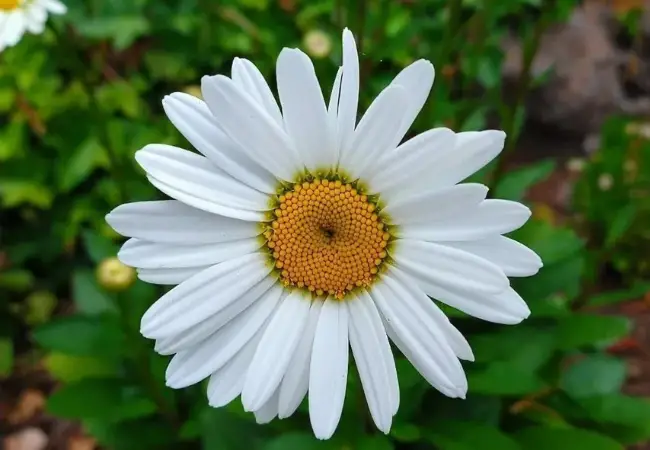Discover the timeless charm of Shasta Daisy. Learn how to grow these easy-care perennials that brighten gardens with cheerful white blooms. Perfect for borders, cutting gardens and attracting pollinators.
Shasta Daisies (Leucanthemum x superbum) are beloved garden classics that bring a touch of simple elegance to any landscape. With their pristine white petals surrounding golden centers, these cheery flowers have been garden staples for generations. In this article, we’ll explore everything you need to know about growing and enjoying Shasta Daisy in your garden.
Here’s an information chart for Shasta Daisies:
| Category | Information |
|---|---|
| Botanical Name | Leucanthemum × superbum |
| Common Name | Shasta Daisy |
| Plant Type | Herbaceous perennial |
| Hardiness Zone | Zones 4-9 |
| Sun Exposure | Full sun to part shade |
| Soil Type | Well-draining, fertile |
| Watering | Moderate |
| Growth Habit | Upright, clumping |
| Height/Spread | 1-3 feet tall, spreads 1-2 feet |
| Special Features | Large, white daisy-like flowers with yellow centers, blooms in summer, attracts butterflies and bees |
What are Shasta Daisies?

Shasta Daisies are hybrid plants created by Luther Burbank in the late 19th century. They belong to the Asteraceae family and are named after Mount Shasta in California. These perennials are known for their long-lasting blooms and easy-care nature.
Popular Types of Shasta Daisies
- Leucanthemum x superbum ‘Becky’ A tall variety with large flowers, known for its sturdy stems.
- Leucanthemum x superbum ‘Snow Lady’ A compact variety perfect for smaller gardens or containers.
- Leucanthemum x superbum ‘Crazy Daisy’ Features frilly, double flowers for a unique look.
Benefits of Growing Shasta Daisies
- Long blooming period Flowers typically appear from early summer to fall.
- Attracts pollinators Provides nectar for bees, butterflies and other beneficial insects.
- Low maintenance Once established, Shasta Daisies require minimal care.
- Excellent cut flowers Perfect for bouquets and floral arrangements.
How to Grow Shasta Daisies
Growing Shasta Daisies is straightforward. Here’s what you need to know:
- When to plant Plant in spring or early fall.
- Where to plant Choose a spot with full sun to light shade. Thrives in USDA hardiness zones 5-8.
- Soil requirements Well-draining soil is crucial. Learn about improving soil drainage from the University of Minnesota Extension.
- Planting Space plants about 1-2 feet apart, depending on the variety.
- Care Water regularly until established. Deadhead spent blooms to encourage more flowers.
Shasta Daisies in Different Garden Styles
These versatile flowers can enhance various garden types:
- Cottage gardens Their simple charm fits perfectly in informal, romantic garden designs.
- Cutting gardens Grow specifically for beautiful bouquets and arrangements.
- Perennial borders Use as a reliable, long-blooming addition to mixed borders.
Dealing with Common Shasta Daisy Problems
While generally easy to grow, Shasta Daisies can face some issues:
- Leaf spot Remove affected leaves and ensure good air circulation. Learn more about plant diseases from the Royal Horticultural Society.
- Aphids Control with insecticidal soap or a strong spray of water.
Companion Plants for Shasta Daisies
Shasta Daisies pair well with other summer-blooming perennials:
Using Shasta Daisies in Landscape Design
Shasta Daisies offer various landscaping possibilities:
- Mass plantings Create a sea of white blooms for dramatic effect.
- Mixed perennial borders Use to provide contrast with more colorful flowers.
- Container gardens Grow in pots for patio or deck displays.
Propagating Shasta Daisies
Shasta Daisies can be propagated through:
- Division Divide established clumps every 3-4 years in spring or fall.
- Seeds Collect seeds from dried flower heads and sow in spring.
Winter Care for Shasta Daisies
In colder regions:
- Cut back foliage after the first frost.
- Apply a layer of mulch around the base to protect roots.
- Learn more about winter plant protection from Gardening Know How.
Shasta Daisies are timeless garden favorites that bring cheerful beauty to landscapes with their pristine white blooms. Whether you’re creating a cottage garden, planning a cutting garden or simply want to add reliable summer color to your borders, Shasta Daisies are an excellent choice. Their easy-care nature and long blooming period make them perfect for gardeners of all skill levels. By incorporating Shasta Daisies into your garden, you’ll enjoy a classic floral display that never goes out of style.
For more information on perennial flowers and gardening tips, visit the National Gardening Association.
For more gardening tips and plant care guides, visit usagardenhub.com.






One comment on “Shasta Daisy : Classic Beauty for Every Garden”